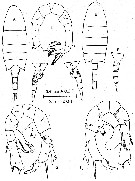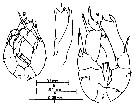|
|
 |
|
Calanoida ( Order ) |
|
|
|
Diaptomoidea ( Superfamily ) |
|
|
|
Pseudodiaptomidae ( Family ) |
|
|
|
Pseudodiaptomus ( Genus ) |
|
|
| |
Pseudodiaptomus australiensis Walter, 1987 (F,M) | |
| | | | | | | Syn.: | Pseudodiaptomus marinus : Grigg,1972; Greenwood, 1977 (p.65, figs.M, Rem. M) | | | | Ref.: | | | Walter, 1987 (p.367, 379, figs.F,M) |  issued from : T.C. Walter in Aust. J. Mar. Fresfw. Res., 1987, 38. [p.380, Fig.8]. Female (from Channel Island, Darwin): A, habitus (dorsal); B, last thoracic segment and urosome (lateral right side); C, idem (lateral left side); D, P5 (posterior view). Male: E, habitus (dorsal); F, last thoracic segment and urosome (lateral right side); G, P5 (posterior view); H, idem (anterior view).
|
 issued from : J.G. Greenwood in Proc. R. Soc. Qd, 1977, 88. [p.62, Fig.5, e-g]. As Pseudodiaptomus marinus. Male (from 27°20'S, 153°15'E): e, P5 (posterior view); f, detail right endopod; g, P5 (anterior view of different specimen). Nota: P5 with small clusters of spinules on coxae; right leg without subsidiary spinule in fork of 'Y'-shaped spine on outer distal corner of exopodal segment 1; the two arms of 'Y' unequal; spine at base of forked spine less than half length of the latter; inner margin of terminal hook on exopodal segment 2 finely denticulate. Right endopod with slender ramus longer than stouter ramus, and with a subterminal seta; stouter ramus terminating in 4 cups, 2 larger and 2 smaller. Left endopod extends only half to two-third length of exopod; inner margin curved, swollen distally, with numerous minute spinules distally and a plumose ridge along outer margin. According to Greenwood these variations are not considered sufficient to warrant separation from P. marinus.
| | | | | NZ: | 2 | | |
|
Distribution map of Pseudodiaptomus australiensis by geographical zones
|
| | | | Loc: | | | N & E Australia (Channel Island: Darwin, Moreton Bay) | | | | N: | 3 | | | | Lg.: | | | (863) F: 1,2-1,27; M: 1,04-1,06; {F: 1,2-1,27; M: 1,04-1,06} | | | | Rem.: | Incomplete data.
After Greenwood (1977, p.65) the Moreton Bay specimens (S = 34.68-33.78 p.1000, t° = 25.8-15.0 °C) show minor differences from those collected elsewhere, but fall within known intraspecific variations regarded as ecophenotypic (see in Grindley & Grice, 1969) and are generally similar to those figured by Brodsky (1948) from the the Japan Sea.
For Chad Walter (1987, p.381) this species is most closely related to P. hypersalinus from Shark Bay (W Australia).
In Ramosus species group (hickmani subgroup) after Walter & al. 2006, p.203.
See remarks in P. sulawesiensis (Nishida & Rumengan, 2005, p.31). | | | Last update : 28/06/2013 | |
|
|
 Any use of this site for a publication will be mentioned with the following reference : Any use of this site for a publication will be mentioned with the following reference :
Razouls C., Desreumaux N., Kouwenberg J. and de Bovée F., 2005-2025. - Biodiversity of Marine Planktonic Copepods (morphology, geographical distribution and biological data). Sorbonne University, CNRS. Available at http://copepodes.obs-banyuls.fr/en [Accessed June 04, 2025] © copyright 2005-2025 Sorbonne University, CNRS
|
|
 |
 |





